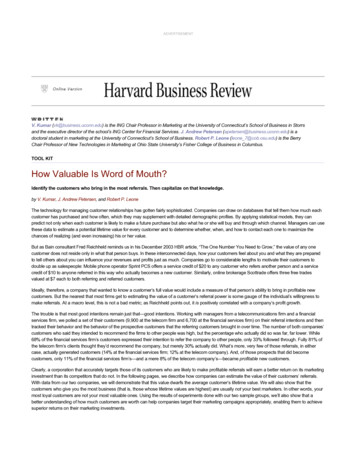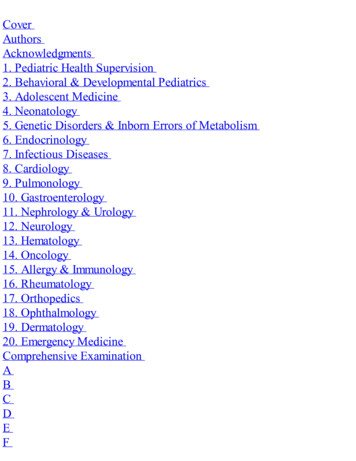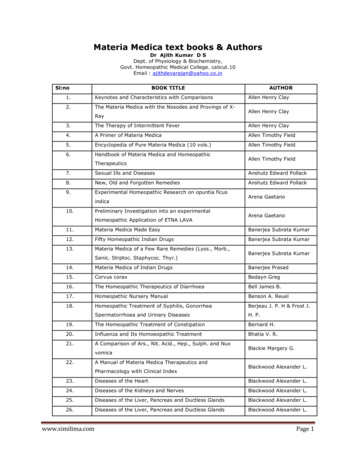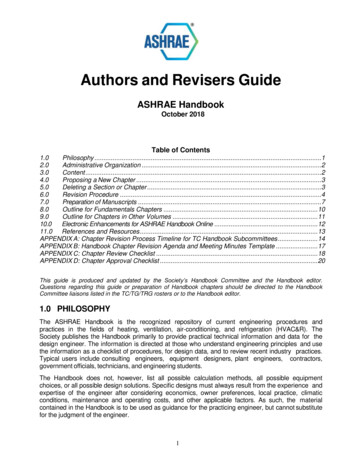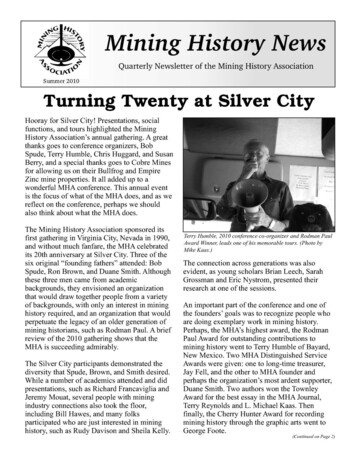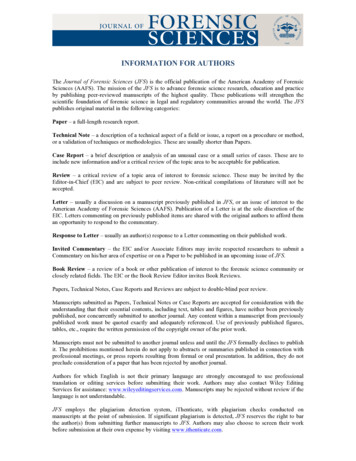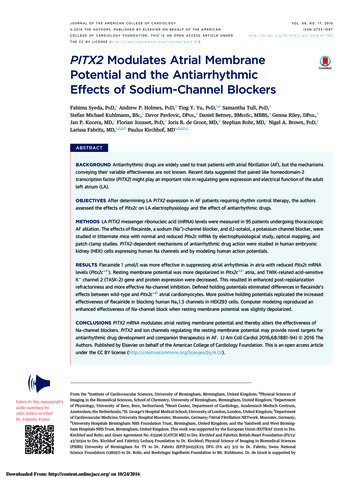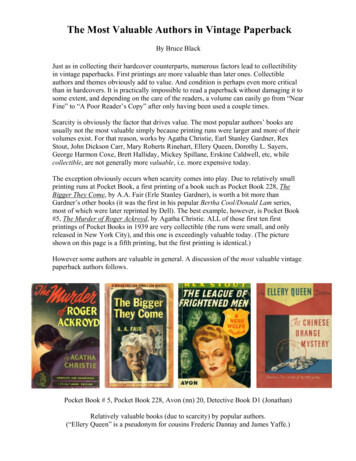
Transcription
The Most Valuable Authors in Vintage PaperbackBy Bruce BlackJust as in collecting their hardcover counterparts, numerous factors lead to collectibilityin vintage paperbacks. First printings are more valuable than later ones. Collectibleauthors and themes obviously add to value. And condition is perhaps even more criticalthan in hardcovers. It is practically impossible to read a paperback without damaging it tosome extent, and depending on the care of the readers, a volume can easily go from “NearFine” to “A Poor Reader’s Copy” after only having been used a couple times.Scarcity is obviously the factor that drives value. The most popular authors’ books areusually not the most valuable simply because printing runs were larger and more of theirvolumes exist. For that reason, works by Agatha Christie, Earl Stanley Gardner, RexStout, John Dickson Carr, Mary Roberts Rinehart, Ellery Queen, Dorothy L. Sayers,George Harmon Coxe, Brett Halliday, Mickey Spillane, Erskine Caldwell, etc, whilecollectible, are not generally more valuable, i.e. more expensive today.The exception obviously occurs when scarcity comes into play. Due to relatively smallprinting runs at Pocket Book, a first printing of a book such as Pocket Book 228, TheBigger They Come, by A.A. Fair (Erle Stanley Gardner), is worth a bit more thanGardner’s other books (it was the first in his popular Bertha Cool/Donald Lam series,most of which were later reprinted by Dell). The best example, however, is Pocket Book#5, The Murder of Roger Ackroyd, by Agatha Christie. ALL of those first ten firstprintings of Pocket Books in 1939 are very collectible (the runs were small, and onlyreleased in New York City), and this one is exceedingly valuable today. (The pictureshown on this page is a fifth printing, but the first printing is identical.)However some authors are valuable in general. A discussion of the most valuable vintagepaperback authors follows.Pocket Book # 5, Pocket Book 228, Avon (nn) 20, Detective Book D1 (Jonathan)Relatively valuable books (due to scarcity) by popular authors.(“Ellery Queen” is a pseudonym for cousins Frederic Dannay and James Yaffe.)
Dashiell HammettOf particular interest to vintage paperback collectors were the pulp magazine authors, andespecially the hardboiled mystery authors in publications such as Black Mask and DimeMystery. Hammett was not the first in the genre, but he was definitely the most famous.His five novels were reprinted by Pocket Book, and while extremely collectible, theprintings were too large to make most of them very high-priced today (the one bigexception is shown below). It is the collections of his pulp short stories that are currentlymore valuable. One of his most popular characters was never named; he was onlyidentified as an “operative of the Continental Detective Agency,” and was thereforedubbed “The Continental Op.” Two of his other main characters are still very famoustoday: Sam Spade (The Maltese Falcon and other works) and Nick Charles (The ThinMan).Pocket Book 268 (3rd prtg in rare dust jacket), Dell 154, Dell 421, Jonathan J36Bestseller B62, Bestseller B81, Dell 379, Dell 411
Raymond ChandlerAn immensely popular hardboiled author, Chandler didn’t start writing until he was 45years old. Chandler’s earliest stories for Black Mask lacked some the panache of his latershort stories and novels, and it’s fun to see his unique talent evolve into the unrivaled useof tough-guy simile and metaphor (many, many writers have tried to duplicate it). Hisseven novels were all based around the same character, Phillip Marlowe. Marlowe waspossibly America’s best-loved PI, tough but sensitive, susceptible to a lady’s charm,knew which cops were on the take and which judges were corrupt, and he was evenknown to turn down his fee if he discovered that his client was crooked.Pocket Book 320, Pocket Book 846, Avon (nn) 38, Avon 63Armed Services Edition 838, Murder Mystery Monthly 43, Pocket Book 212
Cornell Woolrich (& pseudonym William Irish)It’s impossible to talk about “noir” in writing for books or film without mentioningWoolrich. All of his works were “dark,” and some, such as Deadline at Dawn, were setcompletely at night. His personal life was a shambles, and he died a millionaire whileliving alone in a New York hotel room, a crippled alcoholic. One of his stories, It Had toBe Murder, was the basis for Alfred Hitchcock’s movie Rear Window. You could neverreally be sure if his stories would end happily or not, but they were always written in sucha way that you’d be forced to empathize with the main characters, who would struggleagainst psychologically crushing odds. Practically all of Woolrich’s vintage books arehighly collectible and valuable in today’s market.Graphic 108, Popular Library 137, Popular Library 431, Murder Mystery Monthly 27Gold Medal 136, Avon 220, Dell 10 26, Popular Library 473
Fredric BrownA prolific pulp magazine author for Detective Tales and Dime Mystery, Brown startedwriting crime novels in 1947, and then for some reason switched to science fiction in thelate 50’s. He is hugely popular in those genres, and collectors of both have kept his booksin great demand. His works tend to have quirky endings that astonish and delight readers,and while other great authors tend to leave us contemplating great philosophicalquestions, reading Fredric Brown makes us think and it’s also just plain fun.Bantam 302, Bantam 831, Pennant P59, Dell 1st Ed 2EBantam 990, Bantam 835, Bantam 1077, Bantam A1546
Harry WhittingtonWhittington was an immensely popular writer of action novels (mystery, western and“sleaze”) who wrote in true pulp style. His stories are exciting, the characters’ situationsseemingly impossible, and the pace often leaves the reader breathless. In his novel“You’ll Die Next!” an average fellow gets up in the morning, kisses his wife goodbye,steps outside and is beaten to a pulp by a guy that warns him to stop messing with afellow he’s never heard of. He spends the whole book trying to figure out who hisantagonist is and what it is he’s being threatened about. That’s typical Whittington. Hepublished more than 200 novels, and he has such an avid fan base that practically all ofhis vintage books are very valuable.Graphic 41, Ace D-63, Handi 120, Gold Medal 401Uni 58, Gold Medal 740, Graphic 46, Handi 138
David GoodisGoodis appears to be one of those writers that achieved success not just through talent,but also through hard work, churning out hundreds of works for pulp magazines whileremaining a virtual unknown. Then he wrote Dark Passage, which was an instantsuccess, and was almost immediately made into a movie with Bogart & Bacall. Butinstead of riding the wave created by his achievement, he slid back into the pulps, or atleast the “pulp novels,” i.e. the paperback originals that were most commonly publishedby Gold Medal and Lion. It’s as if he lived to struggle, and his noir creations seemed toreflect that. David Goodis was not a happy man. After his death in 1967, his works wentout of print altogether until Black Lizard revived them. He is now one of the mostcollectible of all vintage period authors, and his books are ALL extremely valuable.Dell 221Bestseller B121Gold Medal 226Gold Medal 256Gold Medal 428Gold Medal s1083
Charles WillefordIf I had to pick just one of the authors in this article that is THE most valuable (at least atthis point in time), it would probably have to be Willeford. His writing is down-to-earth,gritty, intriguing, and his characters are so real that they’re downright scary. He was onactive duty in the military, then in and out of odd jobs throughout most of what I call the“vintage paperback era,” and he released only about a dozen titles in the 50’s and 60’s.He created his best know character, Hoke Moseley, much later, in 1984 (Miami Blues).His first novel, High Priest of California, printed as half of a Royal Giant in 1953, barelysold a third of its only printing. It was reprinted later, also by the Universal PublishingCompany, under the Beacon label but they misspelled his name on the cover! Most ofhis works during the vintage period were released by adults-only publishers, and thenwere re-released later as hardboiled mystery/suspense by Black Lizard.Royal Giant 20, BeaconB130, Newsstand LibraryU137, Belmont 90-286
Jim ThompsonIf Willeford’s characters were scary, then Jim Thompson’s were downright terrifying.Thompson wrote about disturbed people that were so realistic, so plausible, that you areforced to believe the folks you see on the evening news talking about a neighbor that“seemed like such a nice, average guy.” Every Halloween, some literary critic writesabout “the scariest books ever written,” and Thompson’s The Killer Inside Me is alwaysat or near the top of the heap. The people in his books invariably start out by taking acourse of action for very logical reasons, and then things just get more and morecomplicated until they’re entirely out of control. Thompson once said that there was onlyone real plot in literature: nothing is as it seems. And all of his books have a “twist” at theend. Jim Thompson’s vintage paperback originals are ALL extremely 1Lion99
Chester HimesChester Himes is most certainly a socially important author of the period, but he is lesscollected than the others in our little study. He is enjoying a definite resurgence ofpopularity in recent years among vintage paperback collectors, at least in part due to abook by James Sallis, printed in 1993 by Gryphon Books, Difficult Lives: Jim Thompson– David Goodis – Chester Himes. Gryphon is the label of Gary Lovisi, who is probablyTHE biggest authority on the subject of collectible paperbacks today, so this made a lotof collectors sit up and take notice. Himes wrote about racism in the 50’s and 60’s, andhis most famous early work was If He Hollers Let Him Go. Later, he wrote a string ofgritty, hardboiled novels about two Harlem detectives named Coffin Ed Johnson andGravedigger Jones. Those books did not do well in America for many years, and he wasgenerally ignored until after his death. Himes’ works enjoyed a resurgence when CottonComes to Harlem became a movie in 1970, and A Rage in Harlem in 1990.Signet 756(cover byAvati)Berkley G-6AvonT-434Avon T-357Berkley F-1262
William Knowles (Clyde Allison)Everyone in our little study so far has had a well-defined niche in the world of U.S. vintageliterature. Allison certainly had his, but there’s a twist. While authors such as Goodis, Willefordand Thompson penned mystery & detective fiction, often dripping with existential undertones,that would sometimes find their way onto the “Adult Rack” in the bookstores and newsstands,Allison wrote purely adult-oriented books from the beginning, and there was never any doubtthey were anything else. But they WERE different because Allison dealt in that realm of adultcomedy so acerbically satirical, that it has to be placed in another category: the “Spoof.” Thebooks primarily make fun of hardboiled detective fiction. But the most pointedly fantastic ofthem all were the “Agent 0008” novels. This may all sound a little TOO tongue-in-cheek to you,but the books are enormously collectible, and they are ALL very valuable.Berkley Y705Ember Library EL333Leisure Book LB1160Ember Library EL317Ember Library EL309Ember Library EL325
Some of the information in this article was derived from:Paperbacks, U.S.A., by Piet Schreuders.1981, Blue Dolphin.The Great American Paperback, by Richard A. Lupoff.2001, Collectors Press.Paperback Prices and Checklist, by Graham Holroyd.2003, iGuide Media.Official Price Guide for Paperbacks, by Jon Warren.1991, House of Collectibles.Hancer’s Price Guide to Paperback Books,Third Edition. 1990, Wallace-Homestead.Two Bit Culture,The Paperbacking of America, by Kenneth C. Davis.Houghton Mifflin Company, 1984.Collectable Paperback Books, by Jeff CanjaGlenmoor Publishing, Second Revised Edition, 2002(1st edition published 2000).Heavy Traffic & High Culture, by Thomas L. Bonn1989, Southern Illinois University Press.Books in Action, edited by John Y. ColeLibrary of Congress, Washington, 1984.Difficult Lives:Jim Thompson - David Goodis - Chester Himesby James SallisGryphon Books, Brooklyn, NY. 1993(2nd printing, 2000).
Those books did not do well in America for many years, and he was generally ignored until after his death. Himes’ works enjoyed a resurgence when Cotton Comes to Harlem became a movie in 1


